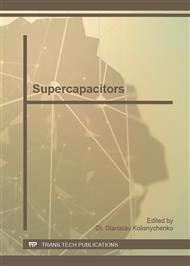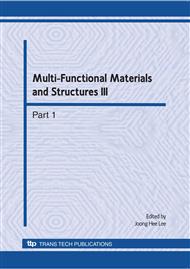p.683
p.687
p.691
p.695
p.699
p.703
p.711
p.715
p.719
Hydrous Ruthenium Oxide Coating on SWCNT Substrate for the Electrode of Supercapacitor
Abstract:
In this study, single-wall carbon nanotube (SWCNT) mixed with hydrous ruthenium oxide was co-deposited on titanium substrate by cathodic deposition method. Titanium substrate was first cleaned thoroughly by acetone and followed by chemical etching of 5%HF for 5 minutes and 50%HCl for 15 minutes. The purpose of acid etching is to increase the adhesion between the coating layer and the Ti substrate. SWCNT has been dispersed by ultrasonic method to avoid agglomeration during deposition processes. The concentration of SWCNT added in the deposition process was 0.05 wt%. The time of specimens which were immersed into the deposition bath is varied from 5minutes to 60 minutes. The electrical capacity characteristics of specimen were examined by cyclic voltammetry. The microstructure of hydrous ruthenium oxide coating is elucidated by high resolution transmission electron microscopy (HRTEM). Combination of amorphous and nanocrystalline structure of hydrous ruthenium oxide was investigated in this study. Nano-sized particles (about 2-3nm) were found embedded in the amorphous matrix. The capacitance was found increased when the deposition time was increased. The maximum capacitance of hydrous ruthenium oxide coating was measured to be 556.7F/g.
Info:
Periodical:
Pages:
699-702
Citation:
Online since:
August 2010
Authors:
Price:
Сopyright:
© 2010 Trans Tech Publications Ltd. All Rights Reserved
Share:
Citation:



